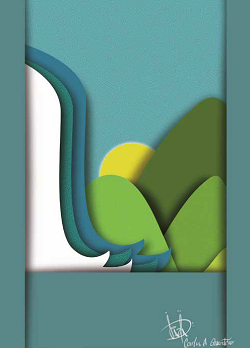Thermals and tourism
DOI:
https://doi.org/10.31908/grafias.v0i34.1249Keywords:
entrepreneur, economic rationality, strategyAbstract
The paper work that will be presented next, has been elaborated by students in thirds semester of Business administration; with the objective to accomplish the targets planned by the university in terms of collective work.
The investigations that were made have as purpose to determine the type or types of rationalities that a manager has for a specific company; since these aspects are fundamental for the functioning, growing and permanence of any kind of organization.
So, concepts about types of rationalities are defined, microeconomic and accounting aspects from the point of view of some theoretical authors as Ortiz, Simon, Nicholson and Snyder, among others. The relevance of this research is considered as consequence of rationality, since the human being has been differentiated from the animals because of the thinking and rational nature, which allows to act according to the reason and not the impulses.
It is defined in EcuRed (s.f) rationality as “the human capability that allows thinking, to evaluate and act according to certain principles of optimality and consistency, in order to satisfy any objective or target”. Likewise, rationality is found in a framework inside the human acting, differentiating that depending on the experience and professionalism that the person has.
<< Rationality accounts for an order of meaning for our acts, which means, what explains an acting the way some laws give sense to the acts. The rationality of modernity (and administration is a daughter of modernity) is considered as instrumental because it is guided by the result of the action>> (Elster, quoted by Castaño, Yepes & Ospina, 2013, p. 31)
References
Adelberg, A., Fabozzi, F., Kole, M. & Polimeni, R. (2006). Contabilidad de costos. 3ª ed. México: McGraw-Hill
AMCO. (s.f). Plan regional de competitividad. Recuperado de http://amco.gov.co/Gaceta/1._Resumen_Introductorio.pdf
Castaño, S. L.; Yepes, G. S., & Ospina, A. G. (06 de 2013). Grafias 21. Recuperado el 22 de 05 de 2016, de http://biblioteca.ucp.edu.co/OJS/index.php/grafias/artice/view/1381/13 9
Claude, S. (1974). Historia del pensamiento administrativo.[traducido de The history of management]. México: Prentice Hall Inc.
Comisión regional de competitividad de Risaralda. Plan regional de competitividad. Recuperado de http://www.almamater.edu.co/sitio/Archivos/Document s/ Documentos/00000073.pdf
DANE. (13 de octubre de 2015). Boletín Técnico. Recuperado de http://www.dane.gov.co/files/investigaciones/pib/turismo/Bol_tec_CST_2013p.pdf
Economía. (1 de septiembre de 2015b). Revista Dinero. Colombia es “realismo mágico” para los turistas. Recuperado de http://www.dinero.com/economia/ articulo/el-turismo-impulsa-economiacolombia-2015/212909
Economía. (25 de mayo de 2015a). Revista Dinero. ¿Cómo se encuentra Colombia en competitividad turística? Recuperado de http://www.dinero.com/economia/articulo/competitividad-turisticacolombia-2015/208809
EcuRed. (s.f.). Recuperado el 22 de 05 de 2016, de http://www.ecured.cu/Racionalidad
Gallardo, Y. & Moreno, A. (1999). Aprender a investigar. Módulo 3. Recolección de la información. Bogotá: ICFES
Giraldo, G. (2007). Racionalidad y ética en las organizaciones. Revista Cuadernos de Administración. Número 38 jun-dic 2007, pp. 53 – 62. Cali. Universidad del Valle.Gómez, A., González, P. & Restrepo, G. (junio de 2004). Ensayos sobre economía regional: Turismo en el Eje Cafetero. Centro Regional de Estudios Económicos Manizales. Recuperado de http://www.banrep.gov.co/sites/default/files/publicaciones/archivos/2004_junio.pdf
González, N. (2000). ¿Consenso sobre la racionalidad económica? Revista estudios gerenciales. Universidad Icesi. Número 76 jul-sept 2000, pp. 49 - 60.>Habermas, J. (1989) El discurso filosófico de la modernidad, Madrid: Taurus.
March, J. G., & Simon, H. A. (1977). Teoria de la organización. España: Ariel S.A.
Ministerio de Comercio, Industria y Turismo (4 de mayo de 2008). Informes de turismo. Recuperado de http://www.mincit. gov.co/publicaciones.php?id=16590
Ministerio de Comercio, Industria y Turismo (s.f). Leyes sobre Mypimes. Recuperado de http://www.mipymes.gov.co/publicaciones.php?id=2492
Mosterin, J. (1977). El concepto de Racionalidad. En teorema VII, pp 55-87.
Nicholson, W. & Snyder, C. (2010). Microeconomía intermedia y su aplicación. [traducido de Intermediate Microeconomics Simón Arbeláez Fernández, Ángela Patricia Hincapié López, María Camila Santanilla Andrade Termales y Turismo S.A.S. ADMINISTRACIÓN DE EMPRESAS 94 Grafías Disciplinares de la UCP, Pereira (Colombia) N° 34, Julio-Septiembre de 2016 and its application] México: Cengage Learning
Ortiz, R. (2005). El concepto de racionalidad. En: La constelación racional. UNA, Caracas. (en línea) disponible en: www.ecognosco.com/pensam/ramonort2.htma. Consultado Diciembre 2005.
Polimeni, R. S., & Adelberg, F. J. (2006). Contabilidad de costos “ Conceptos y aplicaciones para la toma de decisiones gerenciales”. (3 ed.). (G. E. Lopetegui, Trad.) Mexico, D.F.: McGraw- Hill, Inc.
Santos, J. y Vargas Lleras, G. (2014). Bases del Plan Nacional de Desarrollo 2014-2018. 1st ed. DNP Plan de Desarrollo Nacional. Recuperado de https://colaboracion.dnp.gov.co/CDT/Prensa/PND%202014-2018%20Bases%20Final.pdf
Subgerencia Cultural del Banco de la República. (2015). Competencias del mercado. Recuperado de http:// www.banrepcultural.org/blaavirtual/ayudadetareas/economia/competencias_del_mercado
Subgerencia Cultural del Banco de la República. (2015). Sectores económicos. Recuperado de http://www.banrepcultural.org/blaavirtual/ayudadetareas/economia/sect res_economicos
Tamayo (1999). Aprender a investigar. Módulo 2.La investigación. Bogotá: ICFES.
Tamayo, M. (2007). Serie aprender a investigar. Módulo 2: la investigación. Recuperado de http://academia.utp.edu.co/laboratoriomovimientohumano/files/2013/06/2.-La- Investigaci%C3%B3n- A P R E N D E R - A - I N V E S T I G A R - I C F E S . p d f ? f i l e = 2 0 1 3 / 0 6 / 2 . - L a - Investigaci%C3%B3n-APRENDER-AINVESTIGAR-ICFES.pdf


